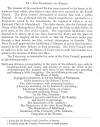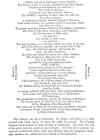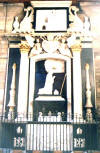Rev. James Sharp,
Archbishop of St Andrews. His mausoleum.
James Sharp has been the
subject of much criticism and indeed venom, for his part
in the persecution of the Covenanters. A more humane man doing his duty is painted by his supporters as evidenced in the memorial his brother erected.
James King Hewison wrote
in The Covenanters ( vol 2 p 123) of Sharp
Sharp appears in his true
colours, verily the `base, clattering claw-back, of his
contemporaries; to the Church a knave `pur sang`; to his
friends, a spy; to his foes, a persecutor; to his peers a
caitiff, whom they used but despised: in fine, one of the
meanest Scots that ever wore a holy robe.
James Mitchell, the would be
assassin of Sharp in 1668, wrote in a letter of February
1674 shortly before his execution:
Sharp was doubtless one of
the chief instigators of the tyranny, bloodshed and
oppression in that dismal period. I, by his instigation,
being excluded from all grace and favour, thought it my
duty to pursue him on all occasions.
These two short quotes only
touch the edges of the complex and frankly evil man that
Sharp turned out to be.
His funeral was splendid both in style and the ceremony attending it. The order of procession is described in The Scotichronicon



Sharp was buried in the Church
of the Holy Trinity in St Andrews where a large and richly
ornamented monument with a life size figure of Sharp
at prayer kneels to receive the crown of martyrdom.
Erected by Sharp`s brother in 1679, and allowing for
brotherly love, the inscription records at sickening and
sycophantic length the alleged contributions to mankind
and Scotland of James Sharp. History and the public
recorded their opinion in 1725 when the tomb was raided,
the body taken and has never been found. It is perhaps
fitting that the now empty tomb really does equate with
the good he is claimed to have done. The inscription
(translated from the Latin in Standing Witnesses by
Thorbjorn Campbell) reads:
DOM – Deo Optimo Maximo, to
God, the best and the greatest.
This lofty mausoleum
protects
The most precious ashes of
a most holy Prelate, a
Most sagacious Senator, a
most sacred Martyr;
For here lies
All that remains under the
sun of James Sharp
Doctor of Divinity, most
Reverend Father in Christ,
Archbishop of St Andrews,
Primate of all Scotland, etc
who
was seen, recognised and
admired
As a professor of
Philosophy and Theology by the University
As a priest, a doctor and a
Chief Priest by the Church
As a Prime Minister in
Ecclesiastical as in Civil affairs by Scotland
As an advocate of the
restoration of the monarchical
Rule of the most serene
Charles the Second by Britain,
As a renewer of the order
of Bishops in Scotland by the Christian world,
As an example of piety, an
Angel of Peace, an Oracle
Of wisdom, and an image of
Graveity by Good
And faithful subjects and
as a most keen enemy of
Impiety, of treachery and
Schism by the
Enemies of God, the King
and the Flock;
and yet who
For all that he was of such
a kind and so great
Was slaughtered in a horrid
manner,
Having fallen on his knees
that he might yet pray
For his own people;
He was pierced through by
very many wounds of
Pistols, swords and
daggers,
By nine forsworn parricides
excited by fanatical
Rage in the full sunlight
of midday in the vicinity
Of his own metropolitan
city
In spite of the tears and
protests of his most dear
First born daughter,
And of his domestic
servants, who had been
Wounded; on the third day
of May,1679, 61 years of age.
This
epitaph just does not gel with the historical facts and
the reams of documentation about events involving
Sharp. As for falling on his knees that he might
pray – it was the exclamation by William Guilline about
the murder and Sharp not being given time to pray, that
gave him away when appearing before the Privy Council. Inevitably episcopalian writers state otherwise.
Back to James Sharp article.
|